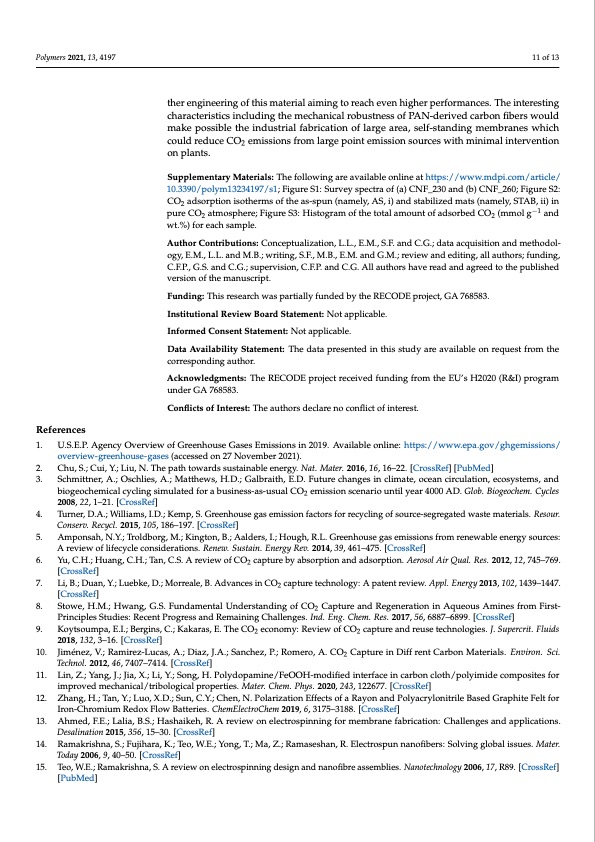
PDF Publication Title:
Text from PDF Page: 011
Polymers 2021, 13, 4197 11 of 13 References ther engineering of this material aiming to reach even higher performances. The interesting characteristics including the mechanical robustness of PAN-derived carbon fibers would make possible the industrial fabrication of large area, self-standing membranes which could reduce CO2 emissions from large point emission sources with minimal intervention on plants. Supplementary Materials: The following are available online at https://www.mdpi.com/article/ 10.3390/polym13234197/s1; Figure S1: Survey spectra of (a) CNF_230 and (b) CNF_260; Figure S2: CO2 adsorption isotherms of the as-spun (namely, AS, i) and stabilized mats (namely, STAB, ii) in pure CO2 atmosphere; Figure S3: Histogram of the total amount of adsorbed CO2 (mmol g−1 and wt.%) for each sample. Author Contributions: Conceptualization, L.L., E.M., S.F. and C.G.; data acquisition and methodol- ogy, E.M., L.L. and M.B.; writing, S.F., M.B., E.M. and G.M.; review and editing, all authors; funding, C.F.P., G.S. and C.G.; supervision, C.F.P. and C.G. All authors have read and agreed to the published version of the manuscript. Funding: This research was partially funded by the RECODE project, GA 768583. Institutional Review Board Statement: Not applicable. Informed Consent Statement: Not applicable. Data Availability Statement: The data presented in this study are available on request from the corresponding author. Acknowledgments: The RECODE project received funding from the EU’s H2020 (R&I) program under GA 768583. Conflicts of Interest: The authors declare no conflict of interest. 1. U.S.E.P. Agency Overview of Greenhouse Gases Emissions in 2019. Available online: https://www.epa.gov/ghgemissions/ overview-greenhouse-gases (accessed on 27 November 2021). 2. Chu, S.; Cui, Y.; Liu, N. The path towards sustainable energy. Nat. Mater. 2016, 16, 16–22. [CrossRef] [PubMed] 3. Schmittner, A.; Oschlies, A.; Matthews, H.D.; Galbraith, E.D. Future changes in climate, ocean circulation, ecosystems, and biogeochemical cycling simulated for a business-as-usual CO2 emission scenario until year 4000 AD. Glob. Biogeochem. Cycles 2008, 22, 1–21. [CrossRef] 4. Turner, D.A.; Williams, I.D.; Kemp, S. Greenhouse gas emission factors for recycling of source-segregated waste materials. Resour. Conserv. Recycl. 2015, 105, 186–197. [CrossRef] 5. Amponsah, N.Y.; Troldborg, M.; Kington, B.; Aalders, I.; Hough, R.L. Greenhouse gas emissions from renewable energy sources: A review of lifecycle considerations. Renew. Sustain. Energy Rev. 2014, 39, 461–475. [CrossRef] 6. Yu, C.H.; Huang, C.H.; Tan, C.S. A review of CO2 capture by absorption and adsorption. Aerosol Air Qual. Res. 2012, 12, 745–769. [CrossRef] 7. Li, B.; Duan, Y.; Luebke, D.; Morreale, B. Advances in CO2 capture technology: A patent review. Appl. Energy 2013, 102, 1439–1447. [CrossRef] 8. Stowe, H.M.; Hwang, G.S. Fundamental Understanding of CO2 Capture and Regeneration in Aqueous Amines from First- Principles Studies: Recent Progress and Remaining Challenges. Ind. Eng. Chem. Res. 2017, 56, 6887–6899. [CrossRef] 9. Koytsoumpa, E.I.; Bergins, C.; Kakaras, E. The CO2 economy: Review of CO2 capture and reuse technologies. J. Supercrit. Fluids 2018, 132, 3–16. [CrossRef] 10. Jiménez, V.; Ramirez-Lucas, A.; Diaz, J.A.; Sanchez, P.; Romero, A. CO2 Capture in Diff rent Carbon Materials. Environ. Sci. Technol. 2012, 46, 7407–7414. [CrossRef] 11. Lin, Z.; Yang, J.; Jia, X.; Li, Y.; Song, H. Polydopamine/FeOOH-modified interface in carbon cloth/polyimide composites for improved mechanical/tribological properties. Mater. Chem. Phys. 2020, 243, 122677. [CrossRef] 12. Zhang, H.; Tan, Y.; Luo, X.D.; Sun, C.Y.; Chen, N. Polarization Effects of a Rayon and Polyacrylonitrile Based Graphite Felt for Iron-Chromium Redox Flow Batteries. ChemElectroChem 2019, 6, 3175–3188. [CrossRef] 13. Ahmed, F.E.; Lalia, B.S.; Hashaikeh, R. A review on electrospinning for membrane fabrication: Challenges and applications. Desalination 2015, 356, 15–30. [CrossRef] 14. Ramakrishna, S.; Fujihara, K.; Teo, W.E.; Yong, T.; Ma, Z.; Ramaseshan, R. Electrospun nanofibers: Solving global issues. Mater. Today 2006, 9, 40–50. [CrossRef] 15. Teo, W.E.; Ramakrishna, S. A review on electrospinning design and nanofibre assemblies. Nanotechnology 2006, 17, R89. [CrossRef] [PubMed]PDF Image | Effect of Thermal Stabilization on PAN-Derived Electrospun Carbon Nanofibers

PDF Search Title:
Effect of Thermal Stabilization on PAN-Derived Electrospun Carbon NanofibersOriginal File Name Searched:
polymers-13-04197-v2.pdfDIY PDF Search: Google It | Yahoo | Bing
Sulfur Deposition on Carbon Nanofibers using Supercritical CO2 Sulfur Deposition on Carbon Nanofibers using Supercritical CO2. Gamma sulfur also known as mother of pearl sulfur and nacreous sulfur... More Info
CO2 Organic Rankine Cycle Experimenter Platform The supercritical CO2 phase change system is both a heat pump and organic rankine cycle which can be used for those purposes and as a supercritical extractor for advanced subcritical and supercritical extraction technology. Uses include producing nanoparticles, precious metal CO2 extraction, lithium battery recycling, and other applications... More Info
| CONTACT TEL: 608-238-6001 Email: greg@infinityturbine.com | RSS | AMP |